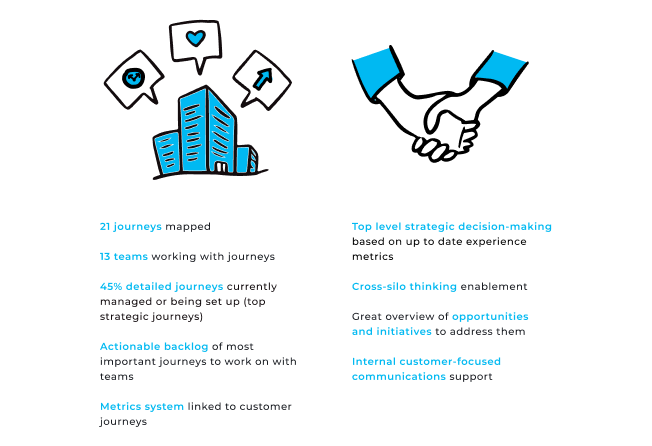What is Customer Journey Management?
Customer Journey Management (CJM) is an approach, a mindset, a clear overview, a customer insight repository, and a tool that helps organisations monitor, optimise, and align their customer experiences across journeys, touchpoints, and teams.
Providing a structured overview of the customer experience across all services and products, CJM enables well-informed decisions across teams and clusters while measuring progress and tracking the results of their CX efforts.
This includes:
- Macro and Micro insightful journeys and their interconnections.
- Ownership and responsibilities for different journeys, phases, and innovation initiatives.
- Integration with metrics and business KPI to measure success and drive improvements.
This customer-centric approach fosters collaboration, alignment, accountability, and continuous customer experience optimisation.
Why is Journey Management important for large companies?
From our extensive experience boosting customer-centricity within different companies, such as the Dutch Railways, we realised that Journey Management is an effective answer to a set of common organisational challenges.
Can you recognise any of these?
- It is a struggle to fully adopt a customer-centric mindset and way of working.
- Customer data is currently not always accessible, consistently documented or usable.
- Collaboration across teams and clusters to improve the customer experience is challenging.
- Prioritising the right opportunities for the customer and making well-informed decisions based on data is difficult.
Then, there is no question you are ready to explore Customer Journey Management.
Key benefits of Customer Journey Management
Implementing Customer Journey Management can transform your organisation inside and out. From making smarter business decisions, driving sustainable growth, and streamlining costs to maximising your return on investment. By focusing on customer needs, you ensure that every effort contributes to long-term success and efficiency.
We’ll take you through the main benefits for different stakeholders.
Value of Journey Management for teams
Smart CX investments
Prioritise areas with the most significant improvement potential, allowing for efficient budget allocation to increase impact.
Monitor the impact of CX efforts
Leverage data-driven insights to evaluate your customer experience and innovation initiatives.
One source of truth
Maintain an overview of high-level macro journeys and detailed micro journeys, ensuring consistency and clarity.
Clarity about mandate
Establish clear ownership and responsibilities for different journey phases, fostering accountability and avoiding double work.
Value of Journey Management to the business
Managing journeys in the right way leads to measurable business value.
37% annual growth in customer satisfaction
Companies with a journey management program see 37% growth in customer satisfaction, as stated by TheyDo.
6% higher yearly revenues
McKinsey’s report ‘The Business Value of Design’ shows that companies that integrate design thinking in their way of working have 6% higher yearly revenues.
50% greater return on marketing investments
Research from the Aberdeen Group reveals that organisations embracing customer journeys generate over 50% more return on marketing investments.
Value of Journey Management for different stakeholders
We’ve seen how different stakeholders thrive when working with CJM.
Collaborating with various teams, we identified key benefits:
- Deeper awareness of challenges and customer needs
- Increased perceived value of journey management
- A clearer understanding of risks and implementation requirements
- Most importantly, nurturing a culture of ownership and innovation
For Leadership
Evaluate the customer experience
Gain a comprehensive view of the entire customer experience delivered by your service, using clusters as input for business reviews.
Connect KPIs/OKRs and monitor
Link journeys, opportunities, and solutions to KPIs/OKRs, then monitor improvements to inform decisions for future innovation initiatives.
Allocate resources and investments effectively
Prioritise across the organisation and direct teams toward the opportunities that matter most.

I have the feeling that I don't have an overview or an idea what the current customer experience is.
For Product Owners
Identify and prioritise opportunities
Make decisions based on customer insights, as journey management provides valuable input for prioritisation and planning rituals.
Clarity in ownership
Understand responsibilities clearly for smooth collaboration across clusters.
Create one source of truth
Gather data from different sources, making customer insights easy, accessible and relevant for various team members, from designers to marketers, business analysts, and developers.
From insight to implementation
Easily connect service improvements with project management tools like Jira.

We get a lot of work on our plate from different directions. I would like to be more proactive and have insights on what is most important for our customer.
For UX Designers
Centralise and standardise
Create detailed flows and story maps in one place and have a uniform way of working.
Collaborate & be inspired
Find out what’s already known and see what other (UX) designers are working on.
Understand the context
Connect your micro journeys to the journey framework to see the impact of our efforts in the bigger picture.
Seamless experiences through design systems
By identifying the service patterns across your customer experience (e.g. a pay flow), you can connect to a design system (source of truth) to create a coherent flow that can be translated across your touchpoints for a more seamless experience.

When solving a specific design challenge, it would be great to zoom out first to understand the full context.
For Service Designers
Centralise and standardise
Map everything you need in one place and have a uniform way of working.
Collaborate & prioritise
Find out what’s already known, see what other (service) designers are working on as well as deciding the most decisive impactful steps.
Zoom in and out
The journey framework, including different levels of journeys, allows a ‘bird’s eye view’ and a detailed view of the customer experience.

Customer data is very scattered across the teams. I have to ask every time what we have and how it all links together.
The real-life impact of managing journeys
Let’s take the example of the Dutch Railways (NS), where we collaborated on implementing a Journey Management framework. The goal? To help NS become more customer-focused.
Together, we tackled four key priorities:
- Embedding a customer-centric mindset into daily work practices
- Ensuring customer data is both accessible and consistent
- Driving collaboration across teams
- Enabling informed and strategic prioritisation
The early results were promising, encouraging a shift toward cross-silo collaboration, clearer visibility of opportunities, and more customer-focused internal communications.
A quick view of what we achieved:

How to get started with Customer Journey Management
Initiating Customer Journey Management (CJM) may seem overwhelming, but it doesn’t have to be!
Focus on the big picture and take it one step at a time. Keep the overall strategy in mind and prioritise gaining momentum if the following is in place:
- Customer-centricity plays a role in the organisation’s business strategy
- Existing customer research and data are present
- Some journey expertise is available within the teams
Investing in Customer Journey Management is a strategic decision that goes beyond improving customer satisfaction. It also fuels business growth and streamlines efficiency. By embracing a customer-focused approach, companies can create meaningful interactions at every touchpoint, building trust, loyalty and paving the way for long-term success.

Ready to turn journeys into business results?
We can be your partner in this customer-centric journey. From research to delivery, we help you set a strong foundation, run end-to-end journey projects and scale Journey Management within your organisation. Let’s discuss how you can benefit from our Journey Management approach.


